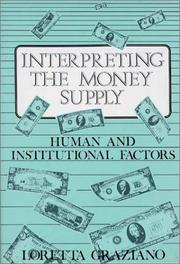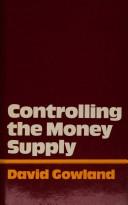| Listing 1 - 10 of 3046 | << page >> |
Sort by
|
Book
Abstract | Keywords | Export | Availability | Bookmark
 Loading...
Loading...Choose an application
- Reference Manager
- EndNote
- RefWorks (Direct export to RefWorks)
eebo-0027

ISBN: 0899301517 Year: 1987 Publisher: New York (N.Y.) Quorum
Abstract | Keywords | Export | Availability | Bookmark
 Loading...
Loading...Choose an application
- Reference Manager
- EndNote
- RefWorks (Direct export to RefWorks)
Book
Year: 1980 Publisher: Cambridge, Mass. National Bureau of Economic Research
Abstract | Keywords | Export | Availability | Bookmark
 Loading...
Loading...Choose an application
- Reference Manager
- EndNote
- RefWorks (Direct export to RefWorks)
A price dispersion equation is tested with data from the German hyper-inflation. The equation is derived from a version of Lucas' (1973) and Barro's (1976) partial information-localized market models. In this extension, different excess demand elasticities across commodities imply a testable dispersion equation, in which the explanatory variable is the magnitude of the unperceived money growth. The testing of this hypothesis requires two preliminary steps. First, a price dispersion series is computed using an interesting set of data. It consists of monthly average wholesale prices of 68 commodities ranging from foods to metals, for the period of January, 1921 to July, 1923. The next step is the delicate one of measuring unperceived money growth. This estimation implies the postulation of an available information set and also a function relating the variables in this set to money creation. The function used was based on considerations related to government demand for revenue. The model receives support from the empirical analysis although it is evident that unincluded variables have important effects on price dispersion.
Book
Year: 1980 Publisher: Cambridge, Mass. National Bureau of Economic Research
Abstract | Keywords | Export | Availability | Bookmark
 Loading...
Loading...Choose an application
- Reference Manager
- EndNote
- RefWorks (Direct export to RefWorks)
Because of a small direct negative effect on private spending, temporary variations in government purchases as in wartime, would have a strong positive effect on aggregate demand. Intertemporal substitution effects would direct work and production toward these periods where output was valued unusually highly. Defense purchases are divided empirically into "permanent" and "temporary" components by considering the role of (temporary) wars. Shifts in non-defense purchases are mostly permanent. Empirical results verify a strong expansionary effect on output of temporary purchases, but contradict some more specific expectational propositions.
Book
Year: 1980 Publisher: Cambridge, Mass. National Bureau of Economic Research
Abstract | Keywords | Export | Availability | Bookmark
 Loading...
Loading...Choose an application
- Reference Manager
- EndNote
- RefWorks (Direct export to RefWorks)
This paper reports an empirical test of a price dispersion equation, using data on the U.S. after World War II. The equation, derived elsewhere from aversion of the partial information-localized market models, relates price dispersion to the magnitude of changes in the aggregate disturbances. In order to test the model a series on price dispersion is computed using annual wholesale price indexes for the period 1948-76. The data on money shocks are the unanticipated money growth series estimated by Barro. The tests also include a measure of aggregate-real disturbances. From the theoretical point of view the results are negative. They reject the hypothesis that unexpected money shocks, as measured by Barro, affect price dispersion in the way predicted by the model. In a previous paper, a similar model was tested with data from the German hyperinflation and found supported to a considerable extent. The difference in the results may be related to the extreme magnitude of the monetary disturbances during that period, and to the apparently important effect of unincluded relative disturbances in the United States.

ISBN: 0709911165 9780709911166 Year: 1982 Publisher: London: Croom Helm,
Abstract | Keywords | Export | Availability | Bookmark
 Loading...
Loading...Choose an application
- Reference Manager
- EndNote
- RefWorks (Direct export to RefWorks)
Book
Year: 1983 Publisher: Basle: Bank for international settlements,
Abstract | Keywords | Export | Availability | Bookmark
 Loading...
Loading...Choose an application
- Reference Manager
- EndNote
- RefWorks (Direct export to RefWorks)
Book
Year: 1998 Publisher: Basle: Bank for international settlements. Monetary and economic department,
Abstract | Keywords | Export | Availability | Bookmark
 Loading...
Loading...Choose an application
- Reference Manager
- EndNote
- RefWorks (Direct export to RefWorks)
Book
ISBN: 9780387139999 0387139990 Year: 1985 Publisher: Berlin: Springer,
Abstract | Keywords | Export | Availability | Bookmark
 Loading...
Loading...Choose an application
- Reference Manager
- EndNote
- RefWorks (Direct export to RefWorks)
Money --- Money supply
Article
Year: 1979 Publisher: 's-Gravenhage : CPB,
Abstract | Keywords | Export | Availability | Bookmark
 Loading...
Loading...Choose an application
- Reference Manager
- EndNote
- RefWorks (Direct export to RefWorks)
| Listing 1 - 10 of 3046 | << page >> |
Sort by
|

 Search
Search Feedback
Feedback About UniCat
About UniCat  Help
Help News
News